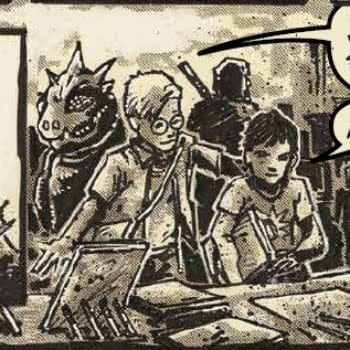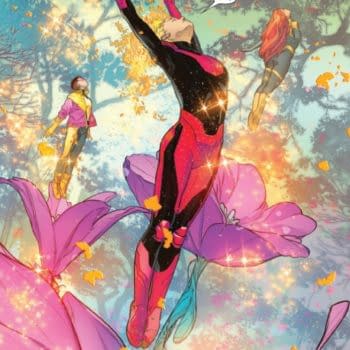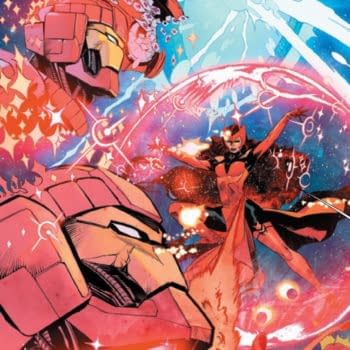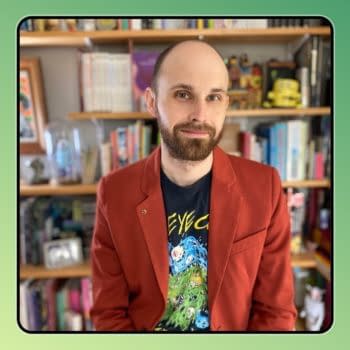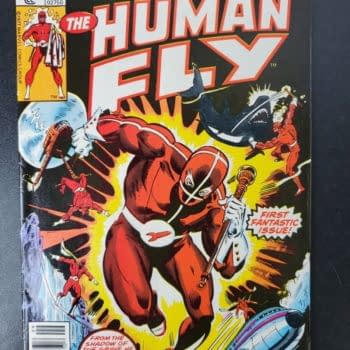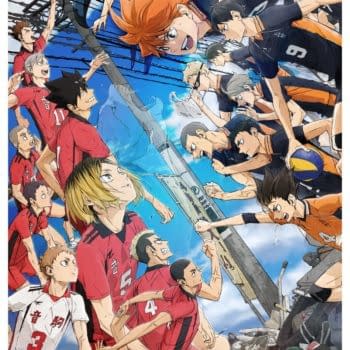Posted in: Comics | Tagged: Comics, entertainment
Zander Cannon On Why Kaijumax May (Or May Not Be) Like The Wire
by Mike Sangregorio
Zander Cannon is the creator of the Oni Press comic Kaijumax which recently completed its second season. The project, described as classic Godzilla meets the HBO prison drama Oz, currently spans two six issue seasons with at least two more on the way. The first season is currently available in a single collected edition with season two to be released as a single volume next year.
Bleeding Cool spoke with Cannon about the comic, its influences, and what fans can expect in the future. For more Kaijumax related goodness feel free to check out Cannon's site and for any of the current issues see your local comic retailer.
Consider this your spoiler warning for any work discussed.
Bleeding Cool: After the release of your twelfth issue overall how does it feel to have two full seasons of complete?
Zander Cannon: It's great! I have to admit that as soon as I got my issues I held them all together in my hand, just to get the heft of it. Really satisfying. 12 issues may not be the most I have done but it's close. Early on in my career I was bad at ending stories, comics being the way they are. Having these seasons be, more or less, self contained means I really have two complete arcs.
BC: For the most part, the single issues can be given to anyone as stand alone stories.
ZC: That was certainly part of the goal. To get you interested then wanting to know more about what came before and what comes next.
BC: You have mentioned this before but is it still the plan to have Season 3 of K-Max focus on the female wing of the kaiju prison?
ZC: I have slightly changed my mind and that will now be Season 4. Next season will be back in the main prison, following characters that we've seen before while shifting focus to provide some backstory. Much of it will be centered on the Creature from Devil's Creek. [Note: This is an American style 'cryptid' that is part of one of the prison gangs, another of which include the more traditional Japanese kaiju creatures.] Everyone seems to find him to be the the saddest character.
I do want to get to the women's prison but for now it seemed important to get back to the premise of the book as it was inspired by Oz, and its men's prison, while Season 2 featured life outside and sometimes on the run.
BC: He is so sad but I'm rooting for him. Every time I see him next to the Mountain I just want someone to get him away from that thing.
ZC: That's what it's all about. We'll see who helps him and if he can help himself. We'll see some backstory to the Mountain as well. [Note: One character is a sentient volcano who speaks in his own unique language that the audience does yet understand.]
BC: You've mentioned that you are a fan of another HBO series The Wire and each season of that show had a theme (eg, the police, the politics, the newspaper). Do you have a similar structure in mind when you are planning out a season of K-Max?
ZC: I wouldn't say I've thought about it in that way necessarily but the first one is about the prison and the second is about society in general. How difficult, or impossible, it is to change your fortune. The book takes a pretty cynical view of the world. The second one broadens what you see of the monster society and shows you how that society works within human society. Things like the equivalent of racial profiling, parolees trying to make a life for themselves, and drug addicts falling through the cracks.
BC: My favorite issue of this season was issue 4 which had the run-down neighborhood of the Deep Ones from the Cthulhu mythos.
ZC: That was one I had been planning for a while and very fun to do. I did find myself having some difficulty with the Lovecraft references. I'm a huge fan of kaiju in general but to do that issue right I needed to quickly catch up on those particulars. The peculiarities in the way he wrote, the little gags, and all of the things that were weird about Lovecraft himself.
BC: You not only have that world down below, in microcosm, but the story itself reads as if it were a Lovecraft story. There are police officers chasing a monster-hooker and there is this nihilistic undertone to it. It feels as if it could have been set in Red Hook a century ago.
ZC: There were so many things that I had been planning from the very beginning that I hadn't found a place for until then, which was really the tenth issue. The interrogation room scene of the odd looking lizardish woman and even the chase of her through that alley.
BC: There is one bit where she smacks her head into this crate and leaves a watery outline of her face. In the middle of this tense scene there is this slapstick that works with the tone you've set so far.
ZC: My editor on the book, Charlie Chu, sent the finished product to another editor at Oni and all you heard was this loud laughter when he got to that scene.
I think I can die happy now as all I really wanted to do was make someone laugh out loud with a bit of farce in a book that is super tragic as well.
BC: The book is funny though and that is a large part of its appeal. That juxtaposition of the intense prison drama and the fact that you've mentioned most characters are drawn so that they could theoretically be portrayed as classic kaiju characters by actors in suits.
ZC: Part of that is just me as a cartoonist. The book was originally pitched as a direct comedy, coming from the two high concepts meeting head on. As I sat down to plot out the book, and I find I do this often with my own work, this high drama just worked its way in. I almost don't worry about that up front since I know that this pervasive melancholy will work itself in.
I just try to make it funny from issue to issue and the misery for these characters works its way in which is funny because people know me as a cheerful person. They read my book and they ask "what the heck is wrong with you, man?" I like to think I leave it on the page.
BC: After Zonn attacked Electrogor in the shower during Season 1 I had no idea what to expect from you but you seem to be pretty normal.
ZC: When I did that issue I was sure everyone was going to think "what is wrong with him?" and I also had Zonn make out with the prison doctor at the end while she is Ultra-sized. That issue was messed-up.
BC: I thought it was interesting to see your main character go through such a tragedy due to your work with the SAGA program for PTSD therapy. You are familiar with helping others deal with real tragedy and that comes through with your characters.
ZC: SAGA was this project with DARPA and the Department of Defense that attempted to help people deal with PTSD through art. When I wrote my comic Heck, from 2007 through 2011, it allowed me to work through this period of sadness stemming from many issues in my professional and personal life. When I began working with Sift, the civilian company overseeing SAGA, that was the idea that hooked me.
When you put those feelings on paper you can begin to make sense of them. The process of getting them down on paper can be so arduous that it almost makes them boring. You have these dark clouds in your mind for so long that working to get them down makes them lose their control over you.
BC: Almost as if you work to make this terrifying thing into something mundane.
ZC: Right. You've felt this sad or anxious feeling so many times and you don't want to feel it anymore. I mean, you never want to feel it but now you can say that it is over. Obviously everyone has their own thing and feels this to their own degree but for me I found it so useful to engage in this art therapy.
BC: To venture a bit more into safer territory, I was not an Ultraman fan before this but I've always been a fan of Godzilla. Is it fair to think of Electrogor as the star of a Heisei era film that we never got to see? Is his reputation as a city destroyer that eventually settled down and had some kids?
ZC: All the monsters we see in this book are more the C and D-Listers, the ones that were maybe in an episode of Ultraman but never had their own movie or faced Godzilla. I always liked to think of Monster Island (in the Godzilla film series) as kind of where the lame, off-brand monsters hung out.
BC: Monsters such as Gabara?
ZC: I love that Gabara! I love All Monsters Attack even though I know so many Godzilla fans hate it. There will be a character in next season that will be based on him and his relationship with Minya in that film.
BC: Can we look forward to the return of Woofy? [Note: The son of a deceased over-the-hill Kaiju crimelord whose demise no one was expecting.]
ZC: Definitely. He's essentially the most powerful player in the prison, what with 'the Little Boy' whispering in his ear.
BC: What is the deal with the Little Boy? In the first season his reign of terror seems to stop when Zonn uses the Pokédex-looking-device.
ZC: Often when I write something I try to keep it as ambiguous as possible, either because I'm not sure which should be made definite and because I want it to be read either way. You will see him again though.
BC: There is a fair amount of original music in K-Max. The Green Humongo has his rap, an original song plays on the radio of the hover-car of one of the Gatchaman-esque prison guards during his commute, and even giant-robot Chisato has a ringtone that is the themesong of a fictional show. Was this planned or did it just happen along the way?
ZC: Alan Moore always used to that, especially during Top Ten. There were instances in that book of radio on the squad car. Superheroes who were also part of a boy band or a robotic rap song. I always really liked that stuff and it was so much fun then. This kind of stuff helps set the scene and you can use it as backdoor exposition or at least add some color to the world. A couple of jokes as well.
I love writing the rap but I'm not a lyricist and that takes forever. The pop song too. I'm not even sure where that came from! Just the option for another joke. It made sense to me that Chisato would be into a fictional, female super-sentai character.
BC: Back when you were working on Top Ten, and my favorite the spin-off Smax, you probably had a very detailed script to work from but here you are on your own. What is the biggest difference in terms of making comics this way?
ZC: I always joked that working from Alan Moore's script is like cartooning Tetris. He's already worked it out and almost sketched it all out in his head, detailing what goes in the one corner and in another. It leaves you little room to decide you might want to stage a scene another way. You're kind of executing it, delivering on something that has already been decided. While that is great, working on something like K-Max means I can be a bit more free.
I want the storytelling to be the most conventional I can, with no more than really five different types of page layouts. I want to tell it in the most straightforward way that I can due to the odd nature of the story matter itself. You're only thinking about what's happening in the story and what the characters are doing.
Heck was a little different. It was straightforward, a pulp story set in Hell, so I felt I could be a little more inventive with things such as layout. With K-Max I want to focus on getting the odd bits of the concept and the characters across in a direct way.
BC: Do you do a full script for yourself?
ZC: No, I never do a script. I have a whiteboard in my studio with notes for each scene. I know the start and end states of each scene, along with any dialogue that I may need to begin it, but I really begin to lay out each scene digitally. I don't have too much dialogue beforehand. I think of it in terms of the visuals, the composition and things such as the color of the sky. Those are going to say more about the story on the page rather than the narration or the dialogue alone.
BC: You previously mentioned that this was the first series that you've done entirely digitally. Why did you decide to do that with this one?
ZC: Each year I do the fake-cover inside the April Fool's issue of the magazine Game Informer. I've been doing that about ten or eleven years now. Each year I would do that a little more digitally. One year I would color it digitally and then I would do the linework digitally and then slowly I figured out how to do things all digitally. Once I had it figured out I could do this series on a timeline that is necessary. If I had to do it all on paper I'd never have this done in the time I'd need it to be.
BC: Early in Season 1 there appears to be a different sort of style than what would come later and what there is now. Was that a conscious decision or did it evolve naturally over time?
ZC: In the beginning I was looking at what James Stokoe had done with Godzilla: Half Century War to try to figure out the type of linework that I might use and over time I realized I would not be able to ink this book the way he had done his own work. Much of this is based on what allows me to work fast as opposed to me trying to say something shockingly different with my art.
BC: Sticking with Stokoe, one of the characters in HCW describes kaiju as "territorial hurricanes" which is what I thought of when reading the Dr. Matsumoto BeetoGor/Gamera story in issue 3 of Season 2.
ZC: I love kaiju but every time a kid in one of these movies goes "go Gamera!" or whatever part of me is thinking "yeah but he did just eat that boat" and I wanted to have that scene. I had just been beginning that issue when I realized the twist. That the kid you'd be focusing on would be Matsumoto and not Kang, who you may think that this is about.
This again began as wanting to do comedy and then the seriousness worked its way in with a child needing to murder a giant monster because it was hurting people.
BC: Even as the issue ends she makes a point of going to this kaiju graveyard on the Moon and mourning the creature, all these decades later, while wearing her giant-robot, old-lady, ladybug looking mech suit.
ZC: Yeah the entire thing is simultaneously super funny, super sad, and super disgusting. There has to be a German word that means that.
BC: At the end of each issue you have your Kaiju Capsule reviews where you spotlight a favorite movie of yours that may not be well known. Issue 6 features Pulgasari the North Korean film from 1985 that is the inspiration for the Kim Jong-il headed kaiju shown in this issue's flashback to the origin of former prison guard, a current police officer, Jeong.
ZC: Jeong is on the first page of the very first issue but that backstory was not planned at all. I named him Jeong because my son is adopted from Korea and his foster family was named Jeong. I had always assumed that the character was from South Korea but then my editor gave me a Kaiju Request [Note: In the early issues Cannon would sketch his favorite suggestions for giant monsters and show them in the letter columns.] of Pulgasari with Kim Jong-il's head. As I was writing this issue he reappeared in my mind.
BC: Jeong has this arc with not wanting to 'power down' from his armored form for fear of "being squished" that is a pretty major narrative through the series. How much of that was planned?
ZC: Originally he was not intended to be part of the battle in issue 6 or even to be seen after he quit at the conclusion of season 1. But I liked him a lot and I thought that the 'armoring up' plot was enough to bring him back and I found him to be useful for exploring plots such as what was going on in the Moon.
Pairing him with Chisato allowed us to explore police work from two different points of views and then his PTSD story was interesting to explore. It's funny to think about it later and realize what exactly it was that did work but was not planned yet still came together well.
BC: It's almost jarring to see how dark his situation gets considering that to most Western audiences he's a Power Ranger, a property not known for dealing with mature themes.
ZC: I think that if someone had pitched it as "Power Ranger deals with PTSD" then, yeah, that would not be fun but I really am trying to approach it from a satirical perspective. Sadness mixed with comedy but not a true action-thriller. Making an action story dark is not as fun for me as making a comedy dark.
BC: The darkness kind of creeps in as you go along, even if it was not intended.
ZC: Exactly and it certainly turns some people off. I've received so many letters about how "this was so much fun up until this point and now I'm going to read a different comic" which is fair enough because you don't want to read something that you're not enjoying.
BC: If what you printed in the letter columns is any indication then you certainly touched a nerve with some of your readers.
ZC: Absolutely and I get it. I've stopped reading comics when they become grim before. The initial arc of Southern Bastards is an example of that. [Note: By Jason Aaron and Jason Latour, from Image Comics.] Some readers assume that they can see where I am going with a plotline as well. That they assume it may get darker, based on what they have already seen, even if that is not what I am intending.
I'm just happy that the people who are enjoying this book are finding it and that they at least can say that this is exactly what they want in a comic.
BC: Back to the Lovecraft inspired issue, you have a character mention that "time is a flat circle" and another say that they don't know what that means. Are you a fan of True Detective and did that inform the detective work of Science Team GREAT?
ZC: The first season of the show, definitely. Not so much the detective work more the weird, pseudo-Lovecraftian connection. It was great to have a drugged-up suspect babble that in the room as opposed to have someone like Matthew McConaughey's character actually be in the police interrogation.
BC: K-Max is a pretty diverse book with all of the human characters being from a country in Asia. Was that an intentional move on your part and what has the feedback been?
ZC: I know that my editor bangs that drum pretty hard about this being the most diverse book on the stands. I have seen mentions of it in various places and the feedback has been positive. It's actually not that 'diverse' considering everyone is of Asian descent but there is not movie studio standing over me demanding that I cast a white actor in any role, so to speak.
All the monsters are from this part of the world so it makes sense that the people would be too. Often you see a work that has one South East Asian character and then they become the SEA character but here we have your older Korean guy, your much older Japanese woman, your Indian prison guard, your Vietnamese etc.
BC: Early on Electrogor seems to be speaking a separate language to the humans from when he speaks to other kaiju. Was that intentional or was that him just trying to be docile and play nice with his jailers?
ZC: I generally try to avoid any worldbuilding but there I did decide early on that there would be two different languages. The monster language that is spoken to each other is all in uppercase while the human language is upper and lower though there are no brackets as there are in older comics. That allows it to be a bit more subtle. Some monsters speak human language better than others and for others it causes problems.
Early on I wanted Electrogor to not know certain words so he would say 'roar' to mean 'talk' and he wouldn't be able to think of the word 'big' because nothing is really larger than he is. He has 'small' and 'not small.'
I had lived in Japan relatively recent to that time and had been thinking about what our word choice says about us and about our culture. There are words in Japanese that have no translation in English and that is important but that became less important as time went on than focusing on the crime drama aspect.
BC: Electrogor's daughter Torgax has a surprising arc, which comes to a head when she reunites with her father in the final issue of Season 2.
ZC: That was in there from the beginning. K-Max was originally going to have a far more compressed timeline with the end of Season 2 actually being the end of Season 1. The idea that she would turn out to be a dangerous criminal/kaiju was always going to be the big surprise. The downbeat ending to follow the upbeat ending of him reuniting with his son.
The idea that she and Electrogor would fight Chisato and Jeong was added later but her aggression and her change was baked in from the original outline. I planned that at least three years ago so it was so satisfying to finally get it done on the page.
BC: It certainly felt satisfying to watch Chisato tear a satellite from the sky and blast a giant monster in the face after seemingly coming so close to defeat.
ZC: Yeah, that was my John Wayne moment. I really wanted the scene of Chisato falling to Earth to be reminiscent of that moment in movies where the asteroid is going to collide with the world of the dinosaurs. Electrogor telling his daughter that "it's all going to be okay" and then you have the Chicxulub event.
BC: It almost appears as if Torgax's time on the outside was worse than her father's was on the inside. As soon as they take down their opponent she immediately defaults to "and now we have to eat him" to the horror of Electrogor. This may not be the first time she's done this.
ZC: Once we finally get to the Season 4 women's prison we'll see her but she won't be the viewpoint character, the Piper Chapman, that will be someone else and she'll be more of an antagonist. This should compare nicely with our current main character considering their relationship.
I find it difficult to make a character purely awful. I'll always give her that relatable side.
BC: That seemed to be the case with Zonn, especially at the end of Season 1. That's a character that never really grew on me.
ZC: I actually originally intended for him to die at the end of that season but I realized that that wouldn't really be enough and that I wanted to eventually have him really blown to pieces or something much worse than what he already gone through. The attack just wasn't a gritty enough death. He has to be our Joffrey but we've also given him another chance to make things worse.
BC: Let's talk about the character of Grubbzo. The backmatter mentions that he was "the first inmate of K-Max" but he's small compared to all other inmates. What diabolical acts did he commit to be locked-up with these giant monsters?
ZC: My studiomates actually suggested doing a comic called Small Time Criminals about the normal sized prisoners including not only Grubbzo but the other creatures identified in Season 2 as his replacements. What do they get up to parallel to what we're seeing the giant monsters do considering that they're really too small to interact with our cast?
BC: Can you talk about the video game Goliath that you're working on?
ZC: This is a game I wrote the primary narrative, the 'golden path,' for because of a relationship I had with one of the developers through my work with Game Informer. Everyone on the project was Russian and I had to come in and write these sort of dialogue trees since a game is nonlinear.
Everything eventually loops back, narratively, but you really get to focus on characters and their individual idiosyncrasies since you're trying to make something engaging more than just advancing the plot. It is currently available for PC on Steam. There may be a port to consoles in the future.
BC: Aside from Goliath and K-Max where else should people look for your work?
ZC: K-Max takes up most of my time now but I do hand-letter the Dark Horse book Mae by Gene Ha, my friend of many years. That's available now.
BC: Have you had a chance to see the new Japanese Shin Godzilla film?
ZC: Not yet, unfortunately, though my specific influences have always been the classic monster movies. The 2014 Godzilla film was great but at the same time I wonder why there was so much focus on trying to have everything in that movie make sense. To me that makes it boring.
Back in the day there was All Monsters Attack. I screened that movie recently for my son and a few other kids and saw how it just gets right to the action with giant monsters body slamming each other. It's great!
Thanks to Zander Cannon for his time!




















